Zoho Crm Importing the Same Leads Again
Before yous can do the import, answering the following questions will help you complete your information import.
- What'due south the source of your data?
- What are you trying to do in CRM?
- What practise you want to import?
What'south the source of your data?
Import from another CRM
You'll need to do the following steps:
- Export the tables from the source CRM into a spreadsheet per module, ensure yous take the IDs.
- Ensure you add together Parent IDs to Child spreadsheets, use vlookups if required.
- Optional – Export the tables from Zoho's destination modules, clear the information to create import templates, leave the column headers.
- Optional – Copy and Paste the data into the Zoho import templates you have created.
- Use the Zoho migration wizard to add the information to the CRM.
Import from an improvised spreadsheet database or generic list
You lot'll need to exercise the following steps:
- Dissever the data into several spreadsheets, one for each module you want to import into.
- Add Parent IDs to Child spreadsheets, utilize vlookups if required.
- Optional – Export the tables from Zoho's destination modules, articulate the information to create import templates, leave the cavalcade headers.
- Optional – Re-create and Paste the data into the Zoho import templates you lot have created.
- Use the Zoho migration wizard to add the data to the CRM.
What are yous trying to exercise in CRM?
Import new records
Use the migration wizard to import new records into the CRM.
Update existing records
Utilise the Import feature from each module. Manually import parent modules first if you're updating more than than ane module.
Update existing and create new
Employ the Import characteristic from each module. An option is bachelor to match existing records using the IDs, whatever non-matches and a new tape is created. Import parent modules commencement; otherwise, the new records could become orphans.
What do y'all want to import?
Non-customers or only one contact per organisation
You demand to import into the Leads module. See my video on Zoho CRM Leads.
Multiple contacts per organisation or customers
Import data into 2 modules, the Accounts (System) and the Contacts. You'll need to import two spreadsheets, one for each.
Organisations with contacts and Sales Opportunities
You'll demand to import three spreadsheets, the Accounts, Contacts and Deals modules. Note, the Deals module contains the ID of both the Contact and Account.
Other data
Import to the other modules directly. Map the parent IDs to the importing spreadsheet – this may mean you take to export the parent spreadsheets and use vLookups to get the parent IDs onto the importing spreadsheet showtime.

Demand more than preparation? Meet which course is right for you.
Become all the training, tips, and templates you lot demand to get it done!
Exporting information from your original database
If you have the data in a source CRM or database, yous'll need to become it out in a format which can exist manipulated. The format of data y'all want is a spreadsheet. You tin export the data from your source system into a CSV file, simply they are usually improve suited to the import process. If yous tin can only export to CSV, copy and paste the information into a standard spreadsheet format afterwards like XLS or XLSX etc.
In the source system, you'll need as many fields as possible. These will course columns in your spreadsheet output. In the example nosotros're using, we want all the Contact fields and all the Organization fields. If you get an ID cavalcade, and then this is useful when linking the tables for the import. Make sure you have a field which exists on both Contacts and Accounts consign spreadsheets. In this example, it is the Organisation proper noun nosotros will be using on the Contacts spreadsheet.
You need unique IDs for all records
I need to explain some basic database theory earlier I tin can hash out the import process. That'due south because when yous import data, such as multiple contacts linked to an organisation, you need to import ii sets of information – the contacts list and the system list.
The theory is straight forward. Let's use the example of multiple contacts linked to a single organisation. Each list of records in both tables need a unique value; this unremarkably means an ID column in each list. In the System list, each Organisation needs a unique ID. This ID could be annihilation. If your source information gives you lot a unique ID, you tin utilise that, meet beneath for an example of the IDs on an Organisation list.
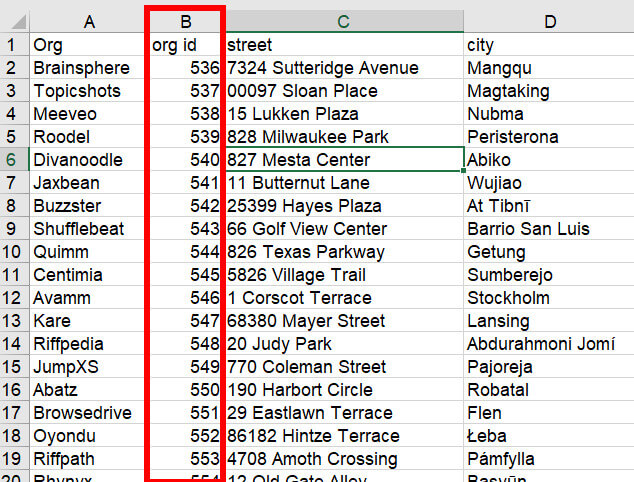
When yous import a listing of new records and specifically Organisation records in Zoho CRM, you tin can import the ID column likewise. This volition so exist replaced by Zoho's own ID values once it's in the CRM.
The Contacts import will also need its own ID column with unique values for each Contact. Even if all the records are unique, yous still need a column with a unique value for the import.
So now you have two separate lists for importing. The problem you take is the 2 spreadsheets aren't linked in whatsoever way.
The unique values in the ID cavalcade are known as keys in database terminology. These keys need to be used to link the spreadsheets together.
Making IDs/database keys for your import
To import records into Zoho CRM, y'all'll need a database primal for each record. If your source database already has a unique value for each row of the exported spreadsheet, and so use that, if non, then read below on how to make your own database keys for the import procedure into Zoho CRM.
Each record in the source database has a unique ID, and this could simply exist a row in a spreadsheet or an bodily tape in the database. When importing fresh records, you will take the chance to create your ain IDs or use the one from your information source.
To create a new ID / key for each unique line on your spreadsheet, follow these steps:
- Create a new column to the right of the unique name of the tape; in our example, it will exist the System Name.
- Add a number, ordinarily "one" in the first cell of this column.
- In the cell directly below it write two.
- Write 3 in the next cell below the 2.
- Select all iii cells and elevate the little square in the corner of the highlighted cells downward the entire column for all the rows in the spreadsheet which contain data. This gives yous a sequential list of unique numbers for that spreadsheet, i.e. your IDs / Keys.
Linking spreadsheets
Zoho CRM uses the ID / Key field to link tables together in order to import the data correctly and non create orphan records.
Nosotros need to be aware of the general database structure and therefore parent tables to know how each spreadsheet links together.
The parent table theory – linking records together
A parent table is a table which exists above another in a hierarchy. Don't confuse this with parent records which is a hierarchy of specific records in the table. The kid table will have the same ID / Primal column as it's parent tabular array(southward). This is to create a relationship between the modules.
Our example is an Organisation having many Contacts. This means the System table is the parent tabular array, and the Contact is the kid tabular array. This gives construction to our importing process as the parent table is always imported first, the ID/central on the parent table as well exists in the kid table and this allows the importing process to link the records together.
For the import process to piece of work, we need to have the Organisation ID/primal on the Contacts import spreadsheet. This is because the import wizard looks to join the Contacts with the Organisations. If the Organisation name is on both the Organisation spreadsheet and the Contacts spreadsheet, you can use this to identify what Organisation ID/Key to utilise and testify it on the Contact spreadsheet. If you remember this is irksome to practice manually, it is. Yet, spreadsheets brand this job incredibly piece of cake and straightforward.
The method to do this in a spreadsheet is called vLookups, and I'll explain how to use information technology below.
vLookups – Calculation IDs from a parent record onto a child tape
To find out parent IDs and add together them to our Child records, nosotros need to use the Excel formula chosen vLookup.
The vLookup formula you need to use in your spreadsheet is:
=VLookup(Lookup_Value, Table_Array, Col_Index_Num, Range_Lookup)
Lookup_Value – This is the value you wish to match on in some other table, in our example information technology is the System proper name in the Contacts table, nosotros use this value to find the Org ID in the Arrangement tabular array.
Table_Array – This is the table you want to discover the information in, in our example, it's the Org tabular array. The first column in the range lookup must be the column that contains the value you lot're matching in the Lookup_Value. You may accept to rearrange your spreadsheet so that the ID field yous want to detect is to the correct of the first column selected in the array.
Col_Index_Num – This is the location the value you want to find is to the right of the first cavalcade in the array. Information technology'south usually the number 1 or two.
Range_Lookup – This is a misleadingly named part of the formula. What it means is, do you desire an exact lucifer of the value to be returned? Oddly it uses the word TRUE to mean non exact and Imitation to mean an exact lucifer. Nosotros always want an verbal match, so FALSE is what we'll apply.
It's a good idea to make the tables you desire to use the vLookup in every bit worksheet tabs rather than split spreadsheets, at least until you have cleaned the information and are ready to import them every bit separate CSV files.
Don't worry if you don't understand information technology yet. I'll provide an example beneath of how it works.
Step 1
Create a spreadsheet with the tabs for the different tables. In our example, we have ii tabs 1 for the Contact and one for the Organisation.
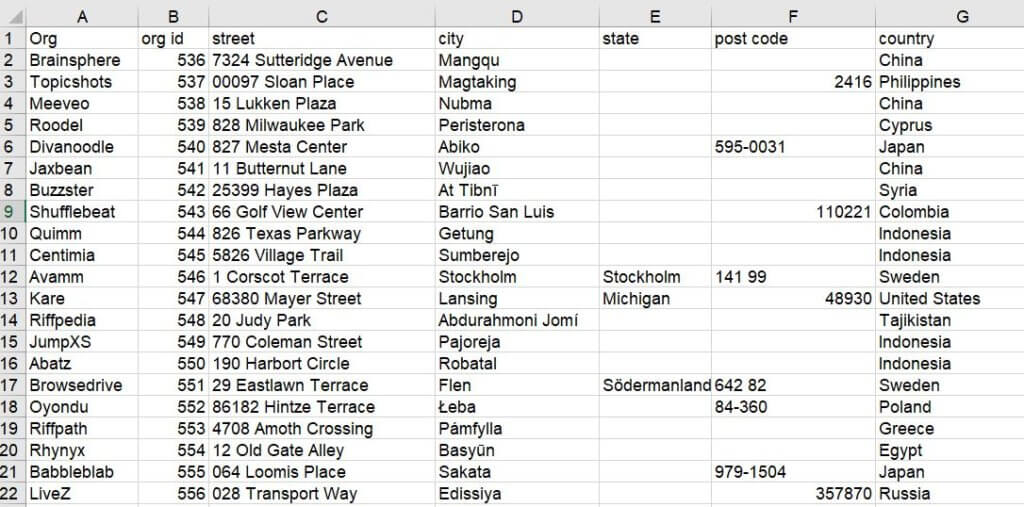
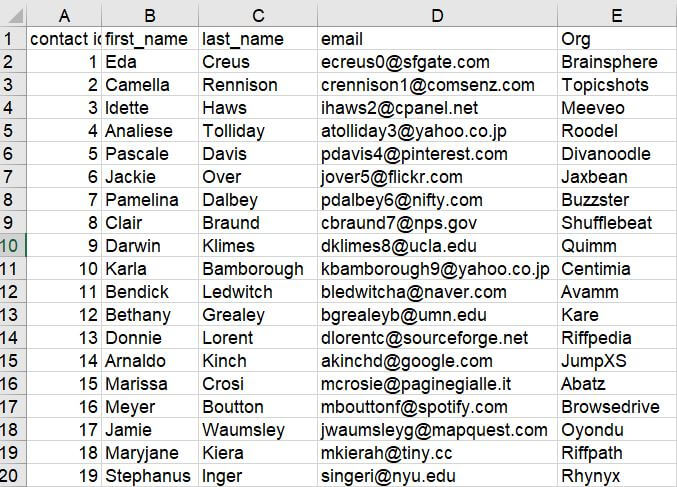
Footstep 2
In the Contact tab, next to the column you desire to lucifer on, create a new column. Side by side to the cell you want to match on outset typing
=vLookup(
This will tell Excel that you lot want to create a vLookup. After the get-go bracket, select the cell y'all want to match, our example is E2. Then add together a comma to become to the next part of the formula.
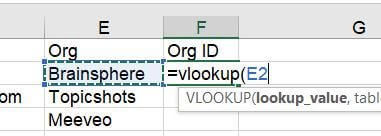
Step 3
You then demand to select the Table_Array. This is the organisation tabular array in the org tab on the spreadsheet. Make sure that when you select the cells in the tabular array, the commencement column contains the data y'all want to match. In our example, it is A1:G101, the name of the tab will automatically be added. Information technology'southward good exercise to add the dollar symbol $ to the array y'all select. This prevents the array from moving when y'all copy and paste the formula into the other cells. This would look like this in our example $A$1:$G$101. Add a comma to go to the side by side part of the formula.

Step 4
Select where the Org ID yous want to bring back is located, nosotros know it's one column to the right of our Org name, then we write 2. Then add together a comma to go to the side by side part of the formula.

Step 5
We want an exact match, so type FALSE. Then shut the formula using a closing bracket. Hit enter when y'all're washed.
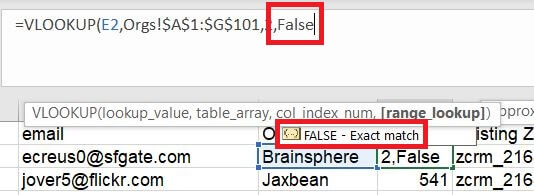
Step 6
If you've done this correctly, y'all'll get the Org ID back. Cheque it matches what you expected on the Organisation tabular array.

Step 7
Copy the formula downward to all the other cells in the aforementioned column. If yous first getting some weird results or the word #Due north/A, and then use the $ sign to lock your tabular array arrays as mentioned above in pace iii.
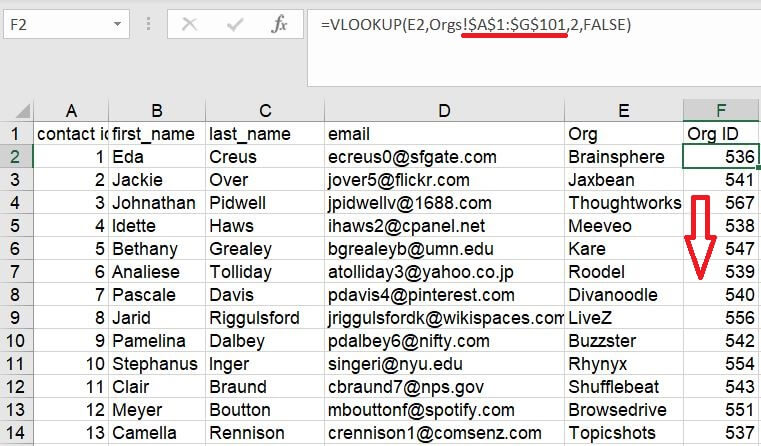
For more than Excel wizardry check out Ablebits fantabulous blog!
Zoho CRM data – example with Zoho
The best do CRM data construction is:
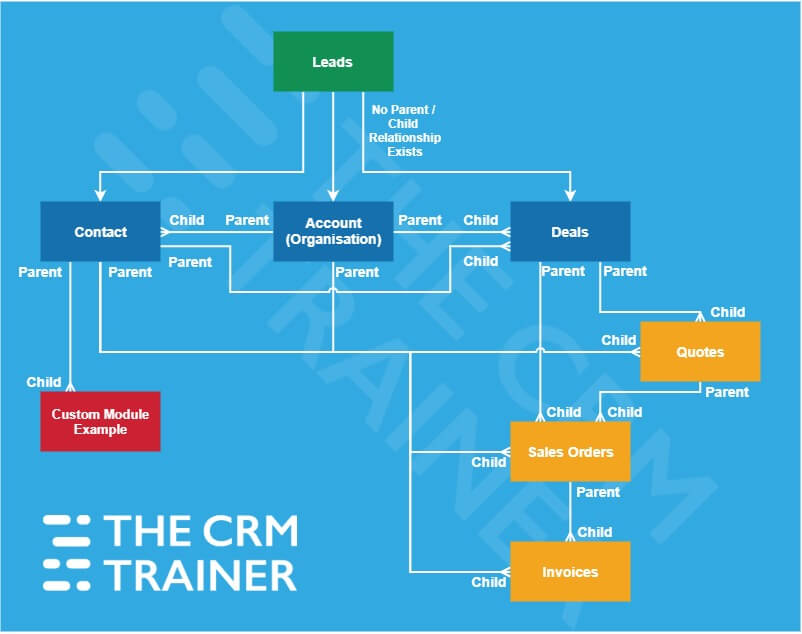
This diagram shows which modules connect to each other and therefore what the kid module is and what the parent module is, this is shown on either finish of each arrow. Y'all can have multiple parent records to a module.
Importing new records into Zoho
Luckily if you lot're importing brand new records (i.due east. not updating existing ones), Zoho CRM's import wizard handles the club in which the tables go in. You will, still, demand to add together both parent and child table spreadsheets to the import sorcerer, call back to ensure the parent ID is on the child record. In our example, this is the Organisation ID/Key on the Contact spreadsheet.
Import restrictions and considerations
- Make sure you have import permission for your user login. If you're unsure, then it's best to inquire an Admin user. If yous're an Admin user, then you'll nearly likely have permission.
- The Migration Wizard import files demand to be in CSV format. If you worked on the files in a spreadsheet, you could save them as CSVs.
- File size can exist a max of 4GB, and you can import up to 200 CSV files in each import.
- The migration wizard allows you to create new modules only resist the temptation to do this. It'due south bad practice to build tables using the migration wizard. Use the builder instead, and y'all'll have fewer problems down the line.
- If you take a checkbox field in the CRM y'all desire to write to, employ the word Truthful or 1 to give you a selected checkbox and the word Faux or 0 for an unselected box.
- Certain characters don't import because they can be used equally field delimiters. Don't include | or "or < or >.
- If yous have values for a multi-select picklist field in your import spreadsheet, make sure to apply the semicolon to separate the values.
- The import volition skip records if you have mandatory fields in the CRM which are missing in the import file.
- Don't get out blank rows between records in your import spreadsheets equally this could exist interpreted by the import wizard as the terminate of the spreadsheet.
Steps for importing Zoho CRM information using the Migration Wizard
Step one
Go to Settings and select Data Import, and then select Data Migration. Select the best option which matches your source location. If you tin can't find a lucifer, I suggest selecting Zoho CRM.
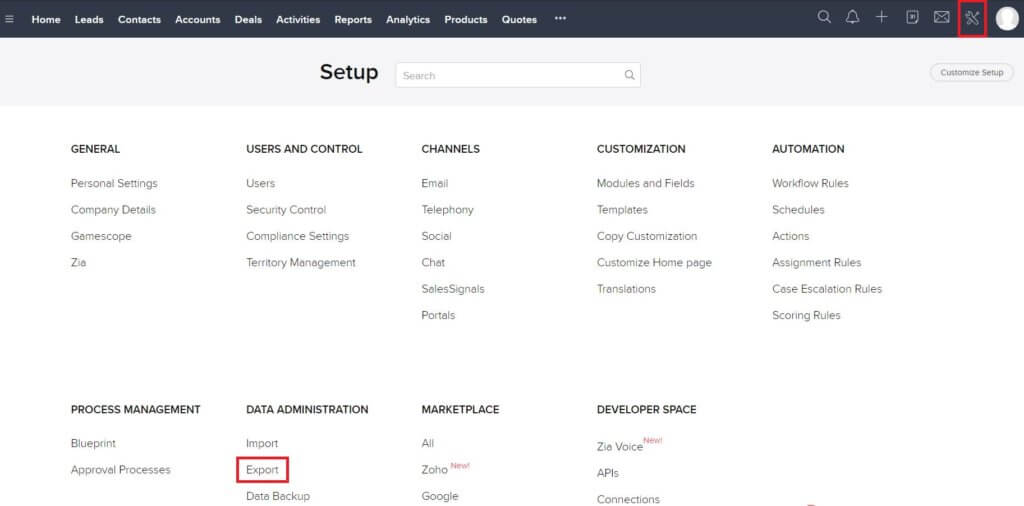
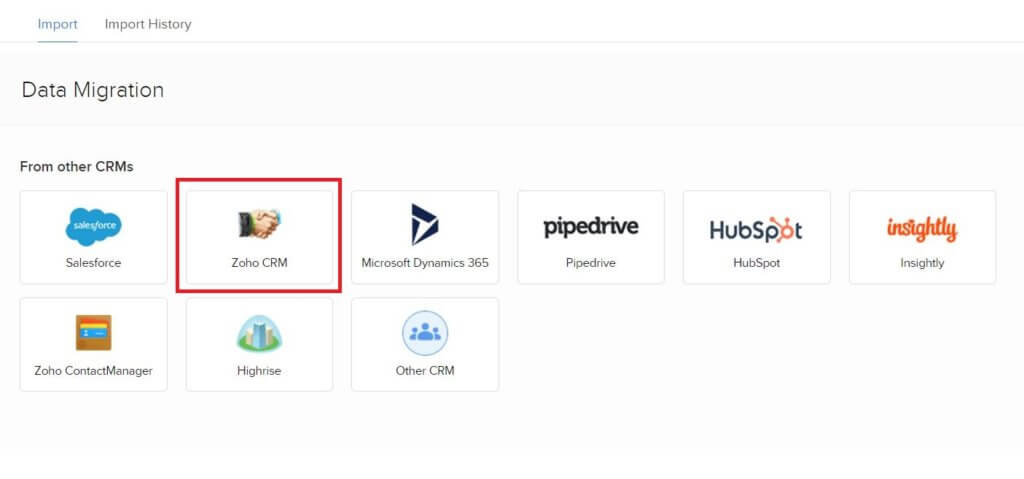
Step 2
Drag and driblet or browse to the files you desire to import. Call up to bring in both the parent and kid tables. In our example, that'south both the Organisations and the Contacts. This must exist in CSV file format. Select Next.
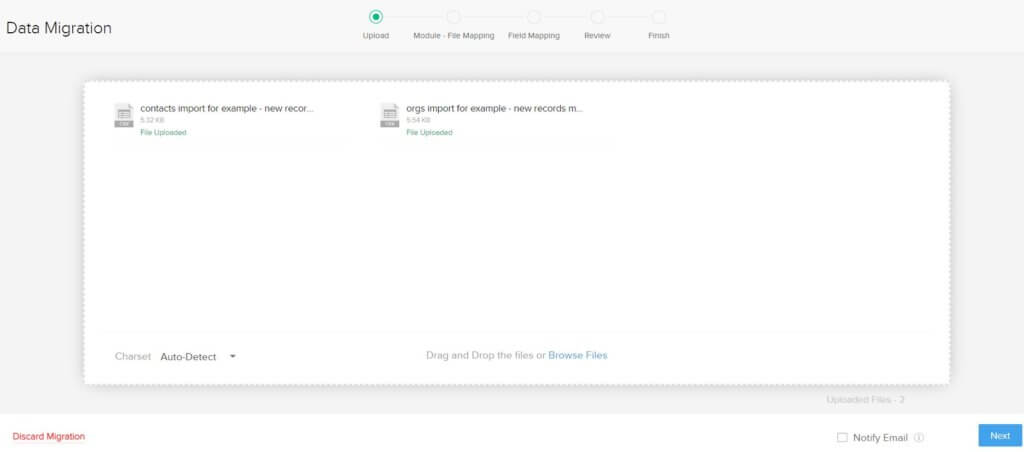
Step three
If you have similarly named files that match the CRM tables, the organization will automatically lucifer the import file to the right table. If non you can drag the file onto the right module icon to map it. Select Next.
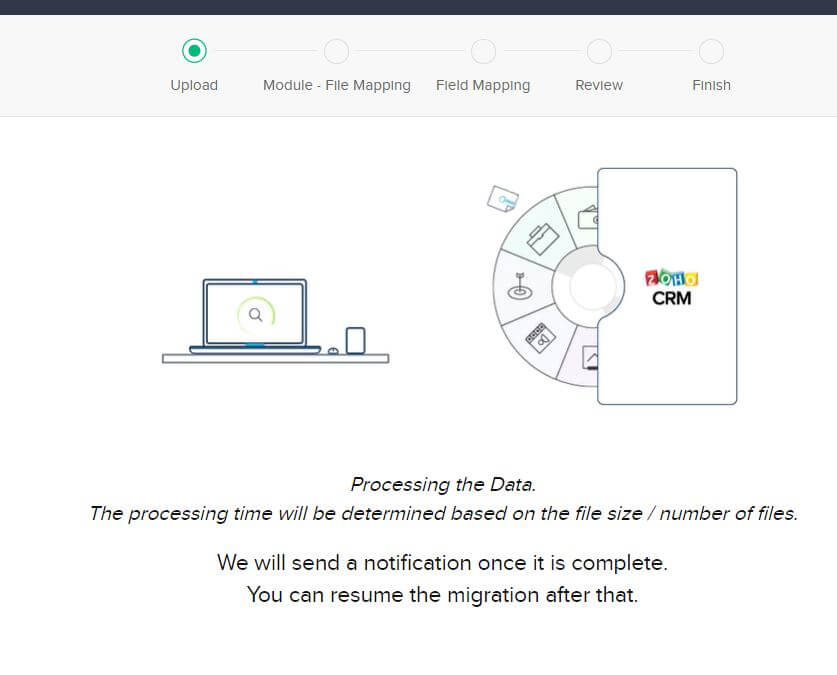
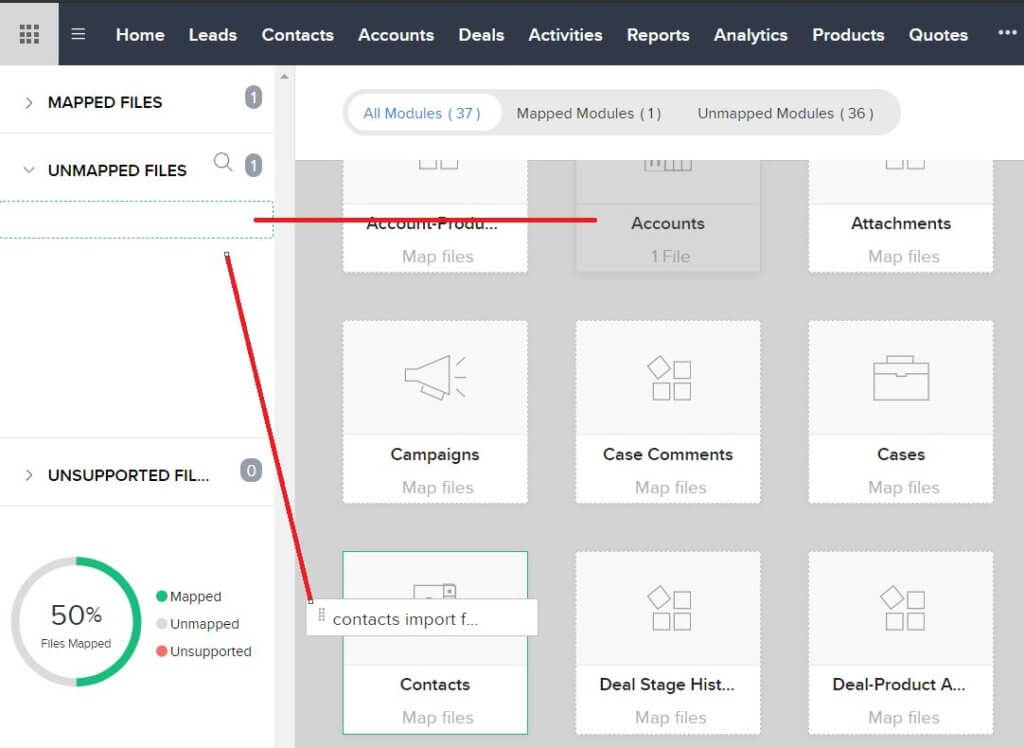
Stride 4
In the field mapping page, yous demand to match the columns in the spreadsheet with the fields in the CRM. Use the right-manus columns which show yous the information in the files and then y'all can exist sure you're matching information technology up.
Remember to map the ID field that you lot may have created. Make certain if you're importing both a parent and child tabular array (east.g. Organisations and Accounts), you lot likewise map the Organisation / Accounts ID field on the Contacts mapping page to the Organisation ID column. Press Next when y'all're ready to select the next table for mapping the fields.
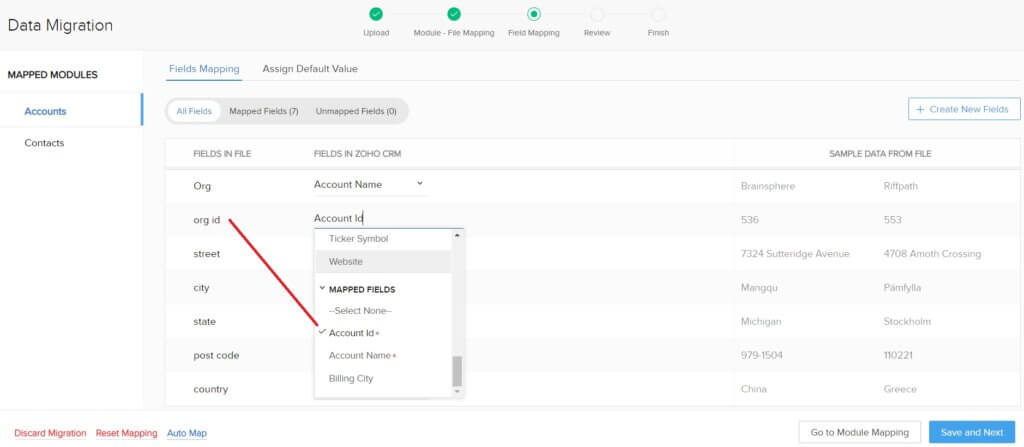
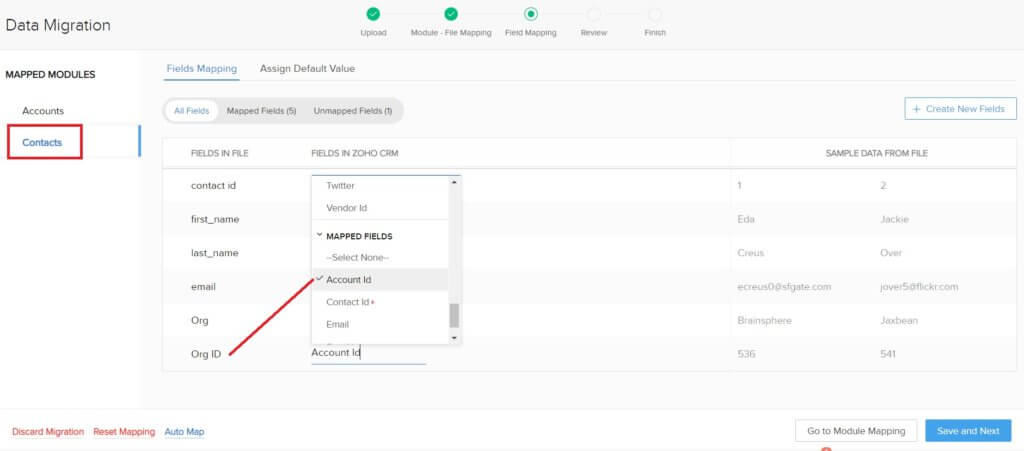
Step five
You can too select default values for any field.
Pace 6
One time you have all the fields mapped in all the tables, select Adjacent.
Step 7
The review page allows you lot to see the status of the import. Select Starting time Migration.
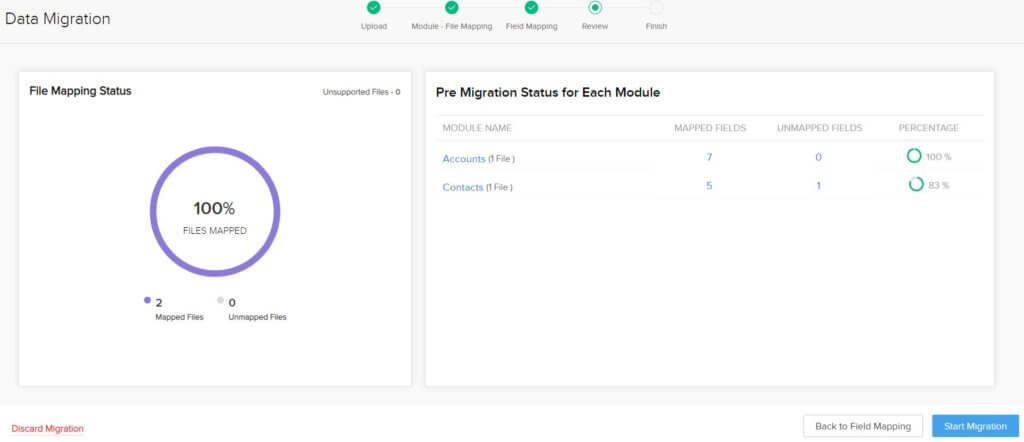
Step 8
If the import is not what yous expected or you made a mistake, information technology'due south easy to undo the import and the records imported will exist erased.
Step nine
Afterward the import, you tin can see which records were imported and which weren't for each module. This allows y'all to review the condition of each unimported record and the reason why. It can then be exported, stock-still and re-imported once again.
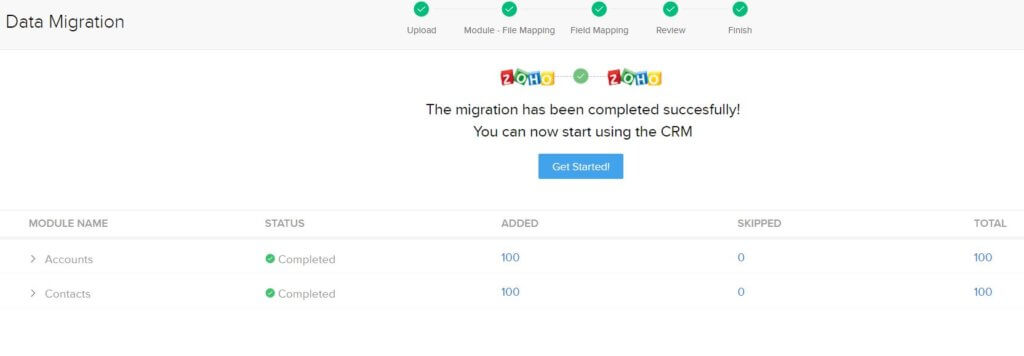
Updating existing records
If you lot're non creating whatever records in your import and but updating the existing data, you'll first need to export the information into spreadsheets to work on them.
Of import: If you're using Zoho CRM, once the data has been imported the get-go time, your original database IDs / Keys you lot used for the import procedure volition accept been overwritten and are replaced by Zoho IDs. You'll demand to export the data from the Zoho CRM to get the Zoho CRM keys, also known equally ZCRM IDs. If yous want to re-import the data, y'all'll need to utilize these keys. Employ the VLookups instructions above to add the ZCRM IDs to the new records y'all are importing.
For example, if y'all want to import new contacts confronting existing Organisations / Accounts, then y'all'll need to export the Account module with the ID columns and use vlookups to add it to the new Contacts Import spreadsheet.
If you have less than 3000 records to export and update, you can use the export wizard. Annotation, don't use a report and export to XLS, because you're unlikely to get the keys which now already exist in the CRM.
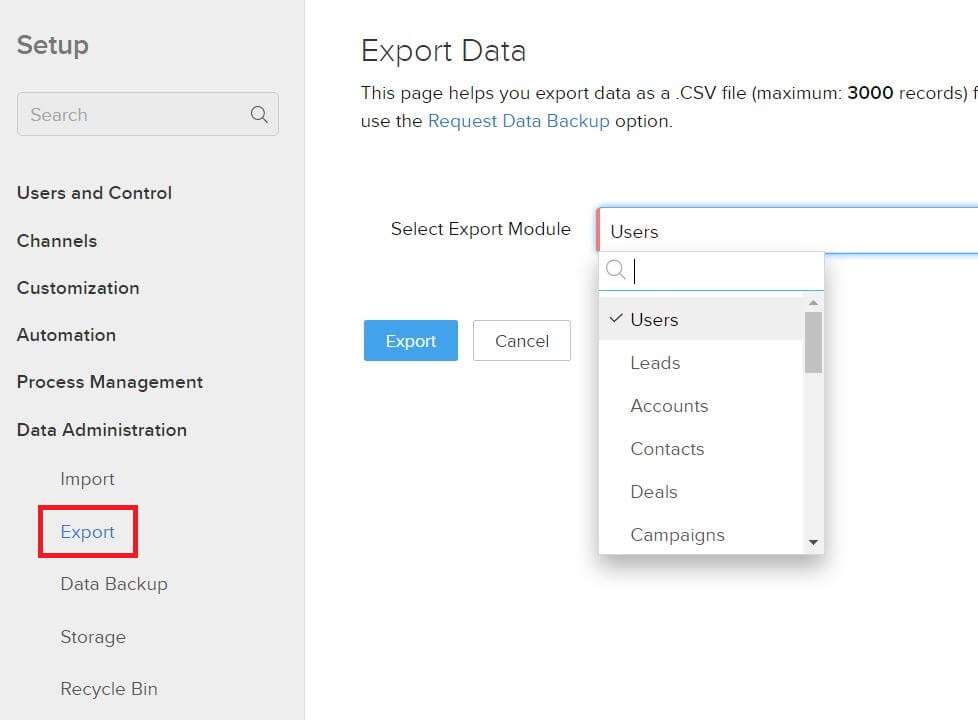
If you accept more 3000 records to export and update, you lot'll demand to employ the information backup feature. You accept two free data backups per month and can request additional ones if you demand to. Follow the instructions on the information backup folio to get the data.
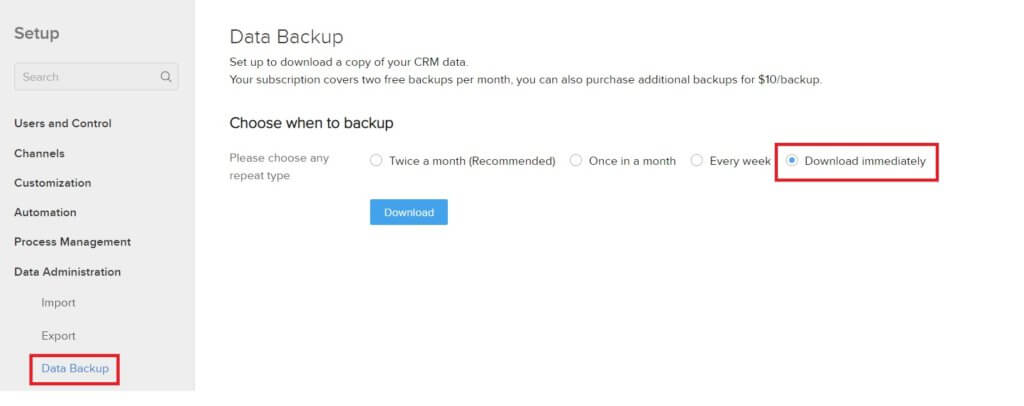
If you need to filter the data subsequently yous've got the consign, y'all can filter within a spreadsheet and remove whatsoever records you don't want to change for the re-import.
If you did it correctly, the parent record IDs already exist in your exported spreadsheet, so don't remove the parent ID columns. You tin delete rows but be careful about removing columns.
When you re-import the data, don't use the data migration wizard, this is only for calculation new records. Instead, you'll take to use the import button on each module page.
When importing the information, you'll get the choice of updating or calculation new records or both, make sure you select the updating choice to avert creating duplicates. You'll be able to match the records in your import spreadsheet with the existing records in the CRM using the ID fields. The ID fields proper noun differs based on what module yous're importing to. The Organisation module will have the field Organisation ID, and Contacts will have the Contacts ID that you need to match upward with your importing spreadsheet column.
Existing Records Import Steps
Step i
Export the data from the CRM and append parent record ID columns with the ZCRM IDs obtained with a vLookup if required. You lot may also need the existing tape ZCRM ID too. In my instance, I've pulled back both the existing Contact ID and the existing Organisation ID to demonstrate this. I've used the unique field email address for the contact. You tin use a chain of showtime name and concluding name too, pretty much anything that is unique. I propose you avert using single names equally this could lead to matching issues. Make sure the file for importing is saved as a CSV.
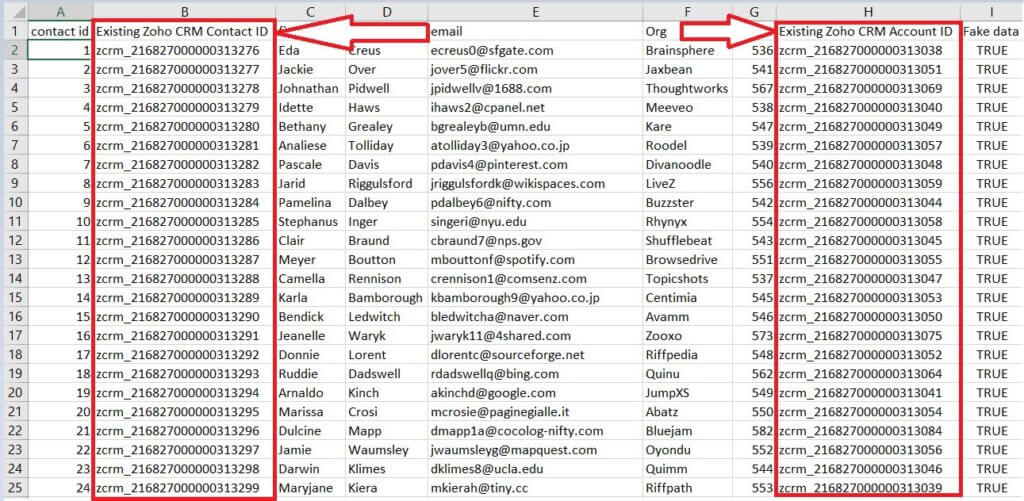
Stride two
Get to the module you want to import data into and select the Import push in the top correct. I'll be importing the Contacts.

Information technology will take yous to an import file folio. Browse to the file to add it and select Next.
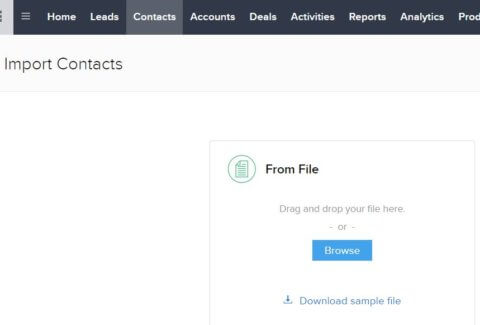
Step 3
Select Update Existing Contacts Only and discover existing contacts using the Contacts ID. You take the option also to employ the electronic mail address, nonetheless, you may not always have the email accost for all the records.
Information technology'due south a practiced thought to avoid update existing fields in your CRM with blank values from your spreadsheet, unless that is what y'all desire to practise. Tick the box to avoid overwriting the information. Then select Next.
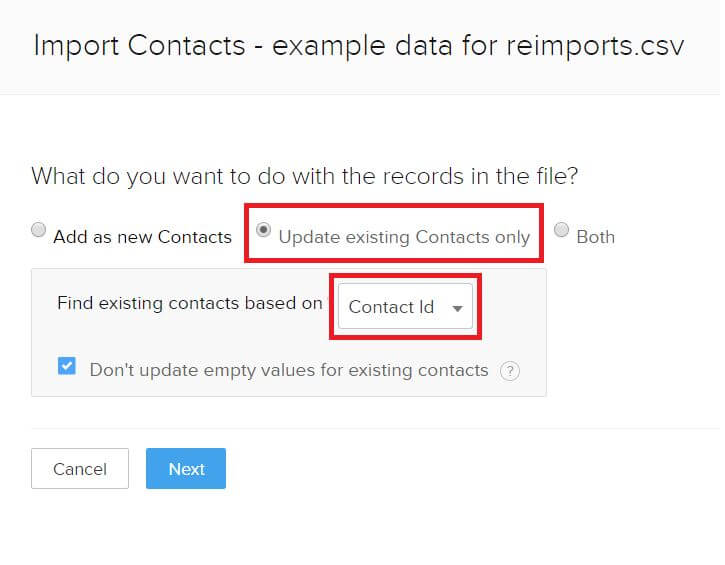
Step four
Nosotros at present become to map the fields. You'll recognise this folio every bit information technology'south very like to the migration folio. Friction match up the fields in your imported spreadsheet with the CRM fields.
In my example, I'g importing Contacts back into the CRM. This means that I'll need to utilize the existing Zoho CRM Contacts ID, which begins with ZCRM. I got this using a VLookup, and we need to use this to match the imported spreadsheet records back to the Zoho CRM records.
You'll notice that when linking the Contacts to the Organisations / Accounts, there's an selection to use Account name or Account ID. It's safer to use the Business relationship ID (found using VLookups) every bit there could be duplicate Accounts in your CRM. You should minimise and eliminate duplicate records in the CRM.
Apply the two columns on the right to see data from your import file to make sure you're mapping them correctly. You lot can also assign default values to fields as well. Don't create new fields from the import wizard. This should be done with care in the Modules and Fields Customisation. Once all your fields are mapped, press Side by side. You may get a popup telling you that non all the fields in your spreadsheet are mapped to fields in the CRM. In a lot of cases, this is fine as we can choose what fields to map and what to ignore.
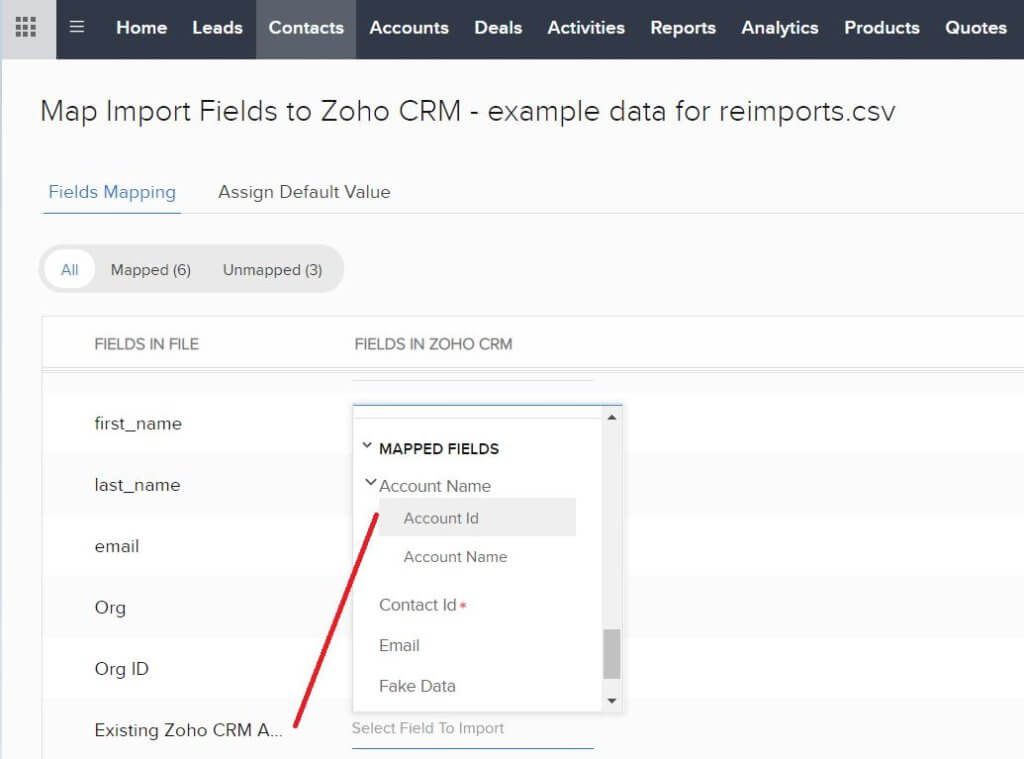
Stride five
The CRM then informs you that your import is scheduled and you'll be notified once information technology is complete. If you want to encounter the status of this import, go to Settings and select Information Administration and so Import, at that place you tin find the Import history. Select it to find more data if any records were skipped and not imported.
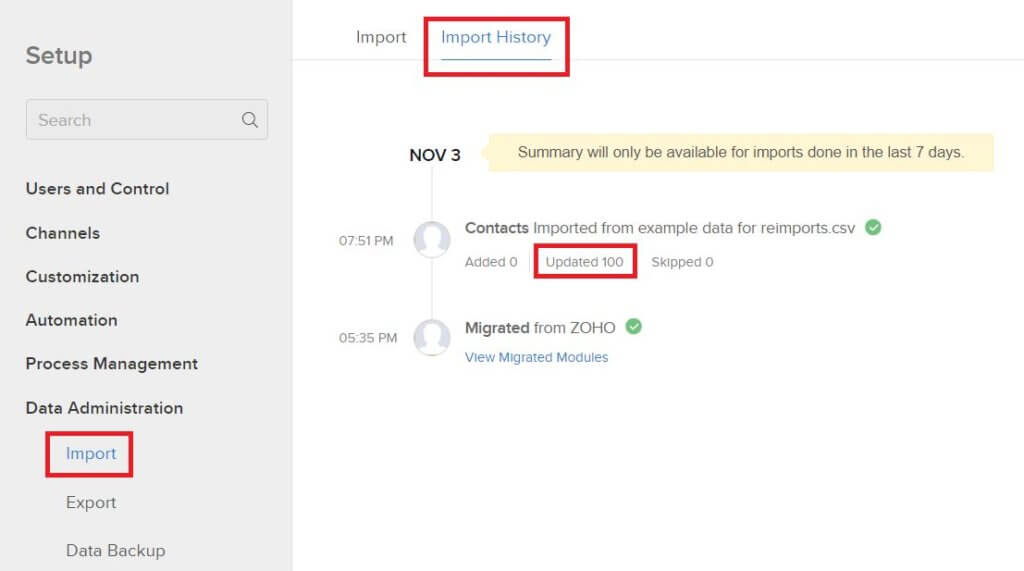

Summary
When importing records into Zoho CRM, you should consider whether it'south new data, you're updating existing data, or adding new child records to existing data. It's straightforward to import data into Zoho CRM as long equally y'all sympathize that every record yous import should have an ID field. You can obtain the IDs from other spreadsheets exported from the CRM or made upward IDs if you're adding new records. Apply vLookups to link the IDs together for your imports.
The price of failing to dorsum upward business data tin can be huge but fortunately, Zoho backups are covered equally part of your service. The data migration and Zoho CRM information import wizards are very easy to utilise and take you lot through the process to minimise the chance of going wrong. However, if you exercise make a mistake during the import procedure, you tin always disengage your import. Even so, this is only for adding records.?
You lot can't undo updated records, simply you can see the history log of each record to see what the values used to be.
Source: https://thecrmtrainer.com/zoho-crm-data/
0 Response to "Zoho Crm Importing the Same Leads Again"
Post a Comment